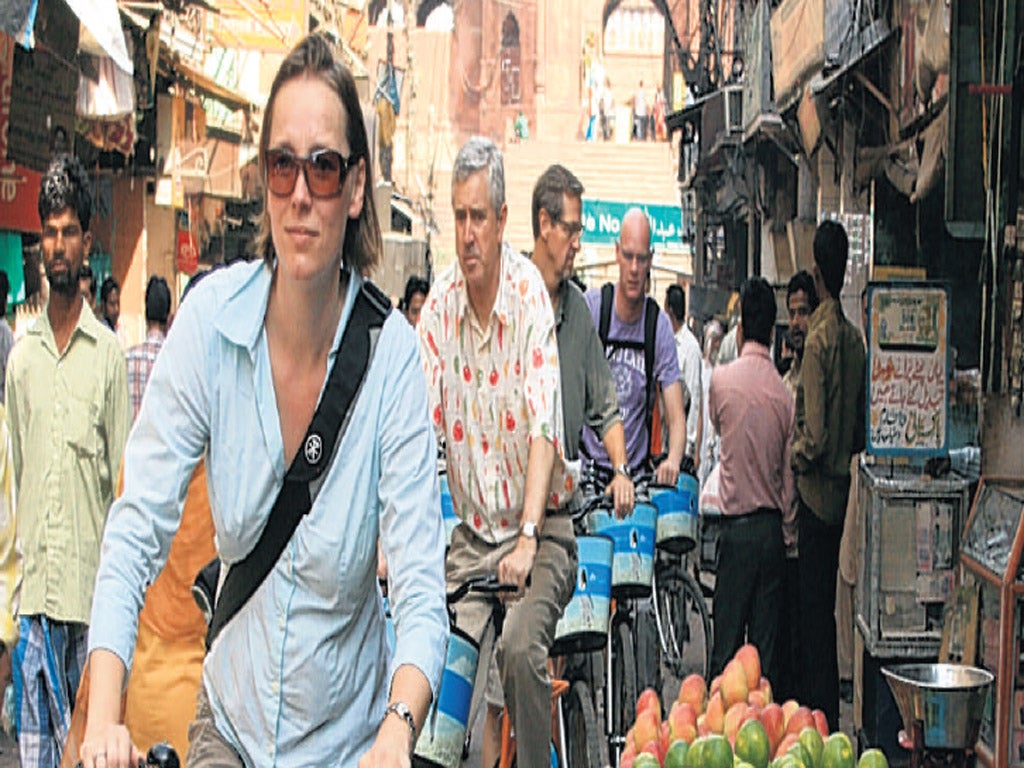Trail of the unexpected: Cycling in Delhi
A cycling tour in the Indian capital throws up some peculiar challenges, as Nick Boulos discovers

The correct way to go round a roundabout? Ask many of Delhi's motorists and the answer is simple: "any way". Braving an onslaught of oncoming scooters and auto-rickshaws with only my bicycle's bell for defence, I pondered my choice of morning activity.
On the face of it, the Indian capital is a bike-friendly place. The terrain is largely flat with miles of cycling lanes. Despite this, few tourists are foolish enough to tackle the chaotic roads, at least at first, without a seasoned pro by their side.
A guided biking tour organised by resident Dutchman Jack Leenaars offers the solution. He launched the tours in 2009 to explore the city's sights and hidden corners.
And one part of Delhi can now be tackled at speed as well. This weekend marks the first time the Formula 1 tour has visited the city's Buddh International circuit. As an example of India's full-throttle drive to modernisation, it's hard to beat.
In the 17th century, Old Delhi was known as Shahjahanabad, a walled city named after Shah Jahan, the fifth and mightiest of the Mughal rulers. His 30-year reign is considered the golden age of the Mughals. He created some of India's iconic monuments, notably the Taj Mahal. I was set to see some more.
The seven-mile bike tours begin early in the day to avoid the worst of the city's heat and traffic. As we set off, my guide Shashank revealed the cardinal rules of cycling in Delhi. "Always use your bell and always give way to vehicles," he said. "And cows."
Crows circled above us as we departed from the Delite cinema, posters of vivacious Bollywood stars bursting from its faded white façade. We veered into Chawri Bazaar, a hardware market and wild scene of honking vans, rickety cars and dazed cattle jostling for space and supremacy. I negotiated my way across, as though caught in the eye of a storm. An auto-rickshaw careered around a corner heading towards me. I braked sharply, but the driver swerved nonchalantly before carrying on without so much as a backward glance in his cracked wing mirror.
Shashank led us to an alleyway, where a crowd of people, dogs and goats were now joined by a succession of tourists on bright orange bicycles. Electricity cables dangled perilously low overhead. Bollywood love songs played on crackling radios, while smiling children skipped to school. The alley narrowed and twisted past shops of sparkling saris and shrines to the Hindu God of Ganesh.
We alighted outside the Gadodia warehouse and ventured up the steep staircase at the back of its dark interior. On the roof, Delhi spread out towards the horizon. Bonnet macaque monkeys somersaulted across the rooftops to the cries of market vendors.
And then rush-hour hit us. We were soon stuck in a grid-locked street of shouting drivers with horns blaring. Poised between a rusty rickshaw and an ox with sad eyes, I turned to find a brazen individual trying to hitch a ride on the back of my bike. As I was going nowhere fast, he thought better of it and vanished into the crowd with a wink.
The roads emptied as we travelled north through the Civil Lines district, where the British settled in the 1850s. We cycled along wide, leafy streets, lined with whitewashed buildings before turning right on Maharaja Lane. Time for chai.
In the shade of a peepal tree, I savoured the quiet as much as the sweet brew. But the tranquillity was not to last. We set off again, bound for Chandni Chowk, Delhi's most frenzied thoroughfare on the eastern end of which the formidable Red Fort stands proudly.
Ahead, a heaving group of people chanted and waved their hands in the air. A protest, I presumed. Drawing closer, I realised it was a funeral procession. The deceased, wrapped in white robes, carried on a bamboo stretcher and showered with crimson rose petals, was en route to the holy Yamuna River for cremation.
I had come to realise that everyone here knew their place on the road. Somehow, it all worked. I still felt vulnerable, but the journey was now exhilarating rather than terrifying.
Jama Masjid, India's biggest mosque, appeared through a cloud of smoke with its unmistakable dome and slender minarets. During Shah Jahan's rule, the great leader arrived for Friday prayers each week in flamboyant style with a procession of elephants. I wonder how he would have fared on a two-wheeler.
Travel essentials Delhi
Getting there
* The author travelled with Travelbag (0871 703 4240; travelbag.co.uk), which offers return flights to Delhi from Heathrow with Virgin Atlantic and three nights at the Taj Mahal Hotel from £1,219 per person.
* Delhi is also served from Heathrow by Air India, BA, Jet Airways and Kingfisher.
Cycling there
* Guided tours with Delhi By Cycle (00 91 11 4661 2428; delhibycycle.com) cost from Rs1,450 (£18).
More information
* India Tourist Board: 020-7437 3677; incredibleindia.org
Join our commenting forum
Join thought-provoking conversations, follow other Independent readers and see their replies
Comments